My husband and I have been living semi off the grid in Alabama for some time now. However, certain state laws have prevented us from going totally off.
Between the two of us, we have a combination of 6 children. We used to joke about this, saying we were a “Brady Bunch” family! As one might expect, the decision to live ‘off the grid’ would not be easy to uphold. It resulted in our having to do a fair amount of explaining in defense of this chosen new lifestyle.
My husband, Stan, is still working full time at a local business. This has allowed me to become a full-time freelance writer. The income I make from writing earns a little income to pay for extras.
Together, we raised our 6 kids. Our family has now more than doubled in size with the addition of 15 grandchildren. We moved out of the large old farmhouse and into a smaller trailer house on the property. We began making preparations for building a little cabin for the two of us.
Related: Mini-Farming on a Quarter of an Acre
The Daily Grind
The Fike’s day starts off very early – around 4 a.m. The average morning begins with me making coffee. Stan wakes up, drinks his cup of coffee, and gets ready for work. Just as anyone else does, he takes out the morning trash and feeds the dogs on his way out the door for work. But today is Stan’s day off – instead of him going into the office he changed up his schedule and is going to help me with the farming chores.
The daily chores begin with feeding the horses, chickens, ducks, rabbits, and turkeys – this is our first priority. After I gathered the morning eggs, I discussed our plan for the day with Stan. We will forage for food and medicines.
As Stan and I are feeding the animals, I recognize a patch of wild Sheep Sorrel that has sprouted within an area known for excessive dampness. Do you know how to tell what Sheep Sorrel is? It is distinguishable by its slightly sour taste – similar to that of spinach or mustard greens.
Sheep Sorrel is an excellent food to combine with eggs and bacon – smothered with cheese it makes a delicious breakfast. Although this is a healthy plant; do not think it is healthy enough to consume on a daily basis. If you eat too much, it can result in the body being unable to process calcium properly due to the amount of oxalic acid.
Here are some step by step instructions for making Sheep Sorrel:
You first must identify the plant as being a green from the spring-time. It prefers wet fields, ditches, and pastures. It is a green plant that has a reddish tint to the stems and leaves. Once it develops the seeds these also turn to a reddish color.
Related: The 5 Most Common Edible Weeds In Your State
Smaller leaves are the most tender, with the best taste. The older leaves have a red tint to them; which indicates a higher acidic concentration, making them very sour.
Here you can see the difference in the color of the leaves.
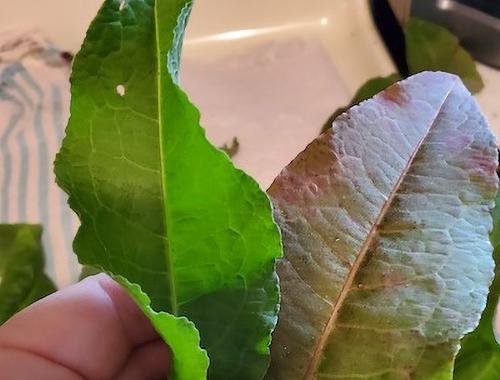
Make sure to check every leaf for bugs and wash them thoroughly in several sinks or pans of clean water.
Then remove the stem. I normally just slide my hand down the woody stem to remove the tender leafy parts.
I add some bacon grease to my iron frying pan or better yet just fry some smoked bacon until crispy.
Remove the bacon and drain it on a plate to the side, crumble it up to later add to the cooked leaves. Now place the chopped/shredded Sorrel leaves to the bacon grease and let them cook until tender.
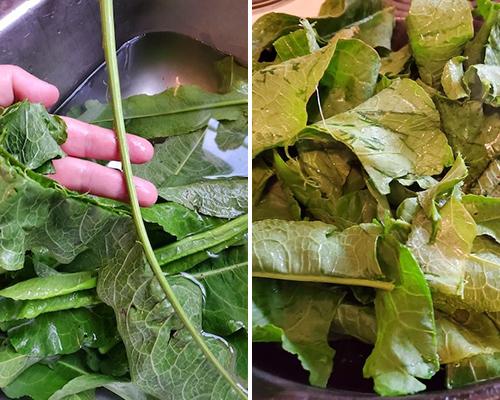
Add the bacon pieces, salt, and pepper to flavor.
Notice, in the below picture how much the sorrel shrinks?
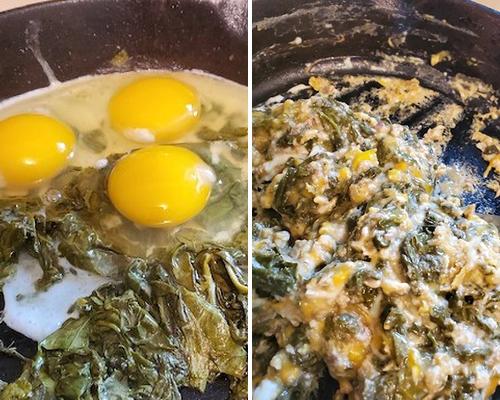
Once it is less than 1/2 the amount in the pan, I add in some eggs.
Next, break some eggs into the cooked sorrel mixture, cook until eggs are almost done. Now, you are going to want to add about a cup of shredded cheese.
Serve this all up with sweet pepper and some Blackberry tea.
The Blackberry leaves for my tea were foraged the previous day and I hung them in the kitchen window.
Once they are completely dry, I place them in a quart-sized mason jar. I crush all the leaves into the jar until it is filled, when it is I will dry can it in the oven to preserve for later.
Related: How To Cook Burdock
More Foraging for Medicinal Teas
Since the dew has dried up a little, we will go out in the woods next to our home to gather some other wild herbs and edibles. Along the way, we have red and white clovers in full bloom. What a treat! This will add to my collection of medicinal teas.
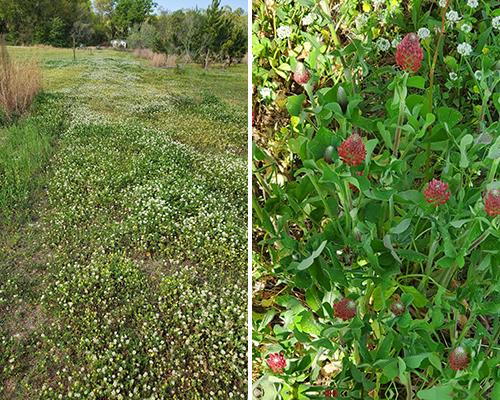
After we have gathered a bowl full of the clover, we head into the woods to see what treasures are there.
Awesome! I notice it is also mushroom season! Tonight we will have some Lion’s Mane Mushrooms. Here is a picture of one of the old logs I discovered with these mushrooms growing on.
Related: Edible and Non-edible Mushrooms you Find in Forests
Gathering Magnolia Bark
Spring is the best time of year for gathering the bark off our Magnolia trees. This is because it is still tender due to the tree’s are coming out of its dormant season.
Stan will use the hatchet and a large knife to remove the bark from the tree and cut it into strips. See how he does in the below photo? He is careful not to strip away too much bark; as this will kill the tree. We do not want to harm any trees!
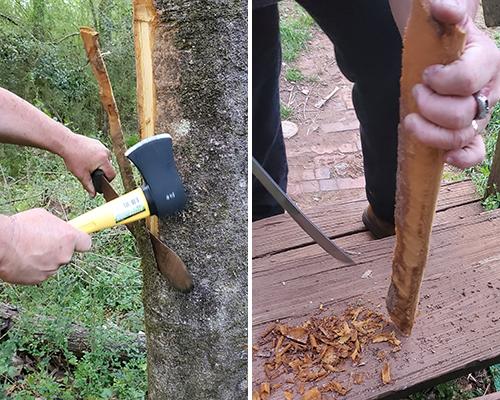
I then take the bark and place it on an old wire screen to dry. This usually takes about 3-5 days depending on the thickness and length of the bark. (You can also dry the bark inside the oven set at 150 degrees Fahrenheit).
I then grind up the dried bark into powder than can later be used as a tea. If you don’t have time to grind the bark into powder, you can break it up into small pieces. This bark mixture can be used to make tea or a tincture.
Breaking tree bark into smaller pieces to form medicinal tea which treats many ailments.
This tree bark medicinal tea relieves anxiety, aids in digestion, and even helps with Stan’s asthma. It is also good to use as an antiseptic for cuts, scrapes, and other wounds. The tea can also be used to gargle with and helps ease the pain of a sore throat.
Whenever I see these flowers, I gather as many as I can. They make an excellent addition to the bathwater, with a lovely scent that is very relaxing. This makes a great way to end the day; an added bonus is how soft it makes my skin feel.
Canning Broths & Soup from Yucca Roots
Today I am canning some broths, soups, and Yucca roots. I am also reorganizing the new pantry. I plan to get as many broths and stocks canned in case the Zombies from the city come looking for food and supplies.
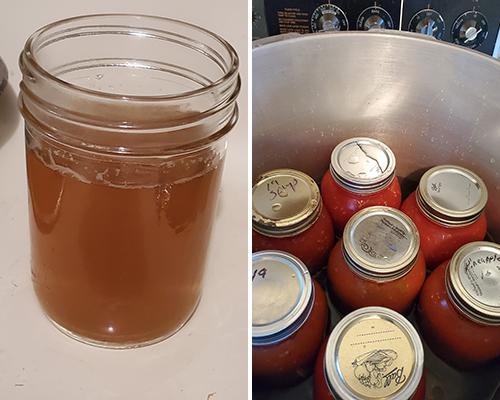
I also dried and jarred up the clover I gathered earlier in the day. We are constantly rotating, dusting, and adding new items to our stockpile.
Our plans are to do some added work on our chicken pen too. Stan will be working on that while I am working inside with the canning, drying, and cooking our meal.
We went to a local live animal auction last week and we purchased several chickens, ducks, and turkeys.
Related: The Ultimate Chicken Meat Processing Guide for Preppers
We have been keeping them in their cages until we can get the pens ready. We might have gone a little overboard and overloaded us this time around. We just got a little excited!
However, we are assured to have eggs and meat in the future. We both love the idea of having all the new animals in our little piece of paradise.
Our son and two of our grandkids came over to help with the chicken pen. This is a great help since this means more will get done by the end of the day. I will just add to the meal tonight to feed everyone.
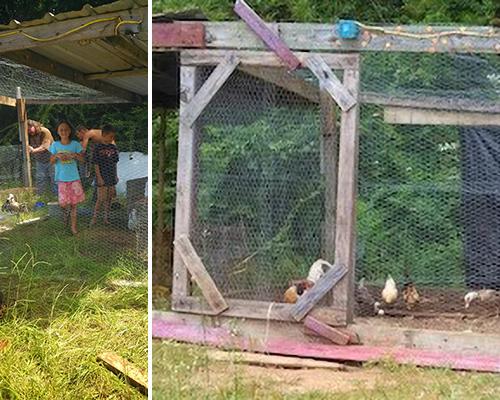
Not bad for just using old pieces of lumber, tin and other items that were thrown out by other people. Like they say – ”one man’s trash is another man’s treasure”.
Winding Down, Reflecting, and Planning for Tomorrow
We can now sit down to our evening meal and begin to relax and unwind for the day. A nice hot bath is going to feel so good after a full day of hard, yet rewarding work. We will all sleep well tonight; but, tomorrow is the start of a new day.
Stan is talking about going fishing. I think we deserve a quiet day of fishing. But you know I will be canning anything extra we catch.
You may also like:
 Confessions Of A Man Who Lived 37 Years Off Grid (AMA)
Confessions Of A Man Who Lived 37 Years Off Grid (AMA)
5 Ingenious Ways To Refrigerate Your Food Without Electricity (Video)
5 Unforeseen Problems I Encountered When I Went Off The Grid

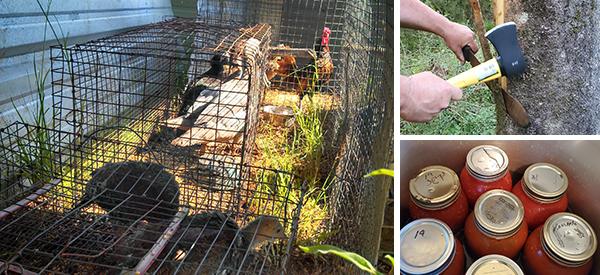
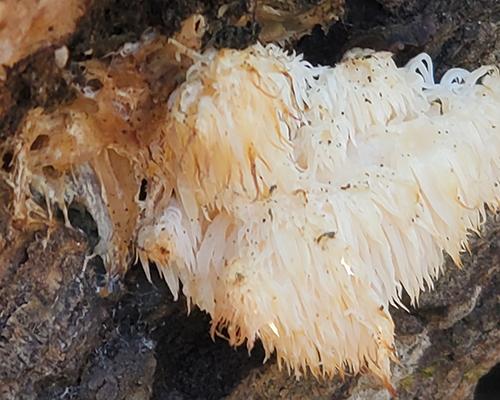













What do you call yucca? The yucca I’m thinking of comes from Africa?
First class writing…. Well done, we need more writer’s like you willing to share their research and knowledge. Good luck to you…
Karen: I think you are thinking of the cassava. This is taken from Wikipedia:
“he natural distribution range of the genus Yucca (49 species and 24 subspecies) covers a vast area of the Americas. The genus is represented throughout Mexico and extends into Guatemala (Yucca guatemalensis). It also extends to the north through Baja California in the west, northwards into the southwestern United States, through the drier central states as far north as southern Alberta in Canada (Yucca glauca ssp. albertana).
Yucca is also native to some of the Caribbean Islands, northward to the coastal lowlands and dry beach scrub of the coastal areas of the southeastern United States, along the Gulf of Mexico and South Atlantic States from coastal Texas to Maryland.
Yuccas have adapted to an equally vast range of climatic and ecological conditions. They are to be found in rocky deserts and badlands, in prairies and grassland, in mountainous regions, in light woodland, in coastal sands (Yucca filamentosa), and even in subtropical and semitemperate zones, although these are generally arid to semi-arid.”
I have personally found yucca as far north as Oregon and Wyoming and as far east as Kansas. As you can see from the Wiki article it supposedly extends as far north as Alberta.
The last time I was in Alberta was 1976 and I really wasn’t closely examining the flora. I was trying to get to Montreal for the Olympics.
Yucca has lots of uses. You can eat the root. You can make soap from the root and you can make rope from the leaves.
I am sure there are more uses but those are the ones I know about.
I read further in Wiki and it says that some yucca roots are not edible because of the saponins that they contain. On the other hand I feel certain I saw yucca root for sale in the vegetable section of our local Von’s which is part of the Safeway chain. The next time I am in that store I will check what I think is yucca root and find out exactly what it is. Of course bearing in mind that not everything on Wikipedia is gospel.
This is the section on uses:
“Yuccas are widely grown as ornamental plants in gardens. Many species also bear edible parts, including fruits, seeds, flowers, flowering stems, and more rarely roots. References to yucca root as food often arise from confusion with the similarly pronounced, but botanically unrelated, yuca, also called cassava or manioc (Manihot esculenta). Roots of soaptree yucca (Yucca elata) are high in saponins and are used as a shampoo in Native American rituals. Dried yucca leaves and trunk fibers have a low ignition temperature, making the plant desirable for use in starting fires via friction.The stem (when dried) that sports the flowers is often used in collaboration with a sturdy piece of cedar for making primitive fire. In rural Appalachian areas, species such as Yucca filamentosa are referred to as “meat hangers”. The tough, fibrous leaves with their sharp-spined tips were used to puncture meat and knotted to form a loop with which to hang meat for salt curing or in smoke houses. The fibers can be used to make cordage be it sewing thread or rope.”
So some yucca may be edible and some not so much. As is typical with wild plants you have to know what you are doing.
There are two plants with similar names one is yuca and the other is yucca.
I think the flower from the yucca is edible, not sure about yuca.
Southern: Yuca is cassava and the root has cyanide. Yucca is our common food plant. I tried the flowers by had a mild reaction, so if I do eat them, they have to be cooked. the fruit is good, if cooked, but bland. Yuca, erk. but it makes good tapioca 🙂 niio
No, tropical yucca/yuca is from S. America and called cassava by the food industry. It’s made into tapioca, a New World favorite. Desert yucca is that skinny brown root in the produce section. That, when boiled, tastes like chestnuts and is good for noodles and bread (use some corn starch or dried canna roots). there are varieties of Yucca (N. American) that can grow in wet areas, high mountains, bitterly cold areas. Some are best to use as soap, but any of them raw work. Raw, but are toxic. Cassava has cyanide, yucca has saponine. niio
Thanks, Red, I was fairly certain that I had seen yucca root for sale in the produce department of our local market but never paid close enough attention to it to make a positive statement. So I assume that desert yucca which is what we here in SoCal are most likely to run into is edible. We have all kinds of yucca growing in the mountains here in SoCal. Makes a great display in late April or early May with the stalks and flower blossoms. Delicate yellowish white flowers with perhaps two dozen blossoms on the single stalk.
chuck: It’s called candles of God. Some roots make better soap, but all of them have to be cooked to be eaten. Raw, when eaten can cause goat-head disease. It makes the brain swell until the skull pops. You saw the article here a while back. If you take the root, drop the top back in the hole and water it. Most survive. niio
Red, don’t people fry the roots as well? Think I remember hearing that somewhere…
Yeah, but it tastes like burned dirt/mezcal. Boil first, then anything else is good. They taste like chestnuts when boiled, and are used in place of for pasta and stuffing. Like potato noodles and dumpling, mix with either wheat flour or, gluten free, corn starch of achira lour (dried ground canna lily roots, and this is the 2nd most expensive starch on the world market). do not neglect the mesquite! We run the washing machine hose to it once a month and get double crops. niio
This is a great story. I love this kind of life. I grew up with it in the middle of the Shenandoah Valley in Virginia in a town of 250 with everyone having an outhouse and outdoor well with a pump. I didn’t know about indoor plumbing until I was 13. Life was hard work then, but when the day was done, you felt good about rewarding and honest days work.
Here is good yucca info from foragingtexas.com
The flower stalk is sweet-tasting before it produces flower pods/flowers. Roast or pickle it before the pods appear. As the flower pods mature the stalk becomes tasteless and tough. After the flowers have past the ripe fruit of the thick-leaf yucca (Yucca treculeana) can be roasted and eaten like eggplant. Thick-leaf yucca is identified by the leaf base being four inches across where it attaches to the yucca’s trunk.
The fibers of the yucca leaf are very strong and have been twisted into cordage for thousands of years. It is best to soak the leaves in water for a week or more to rot (aka retting) away the non-fibrous portion of the leaf which would otherwise weaken the cordage.
Yucca root contains a very high concentration of chemicals called “saponins” which are a natural soap. Native Americans used to put mashed yucca root in a woven bag, which was then dropped into a small pond or stream which had been dammed. The saponins enter into the bloodstream of the fish through their gills, stupefying them. They float to the surface where than can be easily caught. If quickly placed in clean, un-poisoned water the fish may revive and not suffer permanent damage.I
In my experience yucca fruit tends to be full of beetle larvae. Which could be counted as a protein course.
The edible yucca root is cassava root, yucca root is very fibrous and can’t be tenderized by cooking but is very useful powdered and made into a tincture.
Mike: Thanks for the post. Have to remember yucca root for fishing. Sounds quicker and more successful than hook and line or fishing net. Nothing like a little C-4 to gather enough fish for a fish fry.
On Okinawa on the first Wednesday of every month, the 120 mm antiaircraft guns used to fire two rounds a piece from the 3-gun battery that was located about 100 yards from our office.
The biggest problem they had was keeping the Okinawa fishermen out of the impact area because the impact stunned all the fish in the immediate area making for easy harvest.
They were high velocity guns. High velocity, big shell equals lots of muzzle flash, lots of noise, and because we were on a line with the guns, considerable impact from the muzzle blast. Lots of dust, spilled coffee and great consternation for the folks who had not experience it yet.
LCC, c4?! Going a little overboard? Dynamite works too, lol. Another plant we eat that has soapanins is cilantro. Hubby hates it cause he’s sensitive to them so he really tastes it. At least now I know to avoid trying this root with him. Definitely wanna try the fishing idea though…
Hawthorn: He can taste the saponine after cooking? I do like the fishing idea!
Last year I came across a post online with Elmer Fudd, known Biden supporter 🙂 He said, Shot my first turkey today. It scared a lot of people in the frozen food section. I reposted saying it was my stepson. Everybody thought it was hilarious, except him. I got a dirty look for it. He made weapons expert in the Army and has tentative approval from the Ukraine to come over and teach. ! I taught him what little I know, but friends at the armory were his best teachers. Oh, and I told him, you gave me no grandkids to spoil. I have to get revenge somehow for all the gray hair you put on me. And as they sound too much like those little, innocent misdeeds of my own, I will cut this off before I taste toe jam 🙂 You know you’re having too much fun when the cops show up… niio
chuck: You do know how to have fun 🙂 niio
Outdoor life those are the real organic you get everything wrong natural you cope with less oil. If anyone ever had roast eggplant it’s delicious you get a couple flakes of garlic make some holes into the eggplant and take the flags of garlic and place it into the eggplant. When the eggplant get very soff you keep turning in around and it is very soft you take it with a fork and take off the altar Leah skin on my s*** up add a bit of salt and you have a very tasty meal
I’m on the grid. But I can easily convert to off the grid if necessary. No biggee. I’m already partially off the grid now and can covert the rest to off grid.
Note to the author: Hanged is what you do to humans, ie., “Hanged by the neck until quite dead.”
Plants and other inanimate objects and animals are hung. Meat is hung in the smoke house.
Word usage is important to convey the exact meaning of which you write.
A good example was an article a few months back where the word usage of the write was ambiguous. One poster suggested he meant for diarrhea and I thought he meant for constipation. While we were both at the right end, the ailments we though were referred to are quite different in symptoms.
Let he who is without sin cast the first stone. . . .”the ailments we THOUGHT were referred to . . .
Teresa, well written, but I live in Arizona! But, same here for much of it. The flower beds are in full bloom with very pretty radishes we want to save the seeds from, nasturtium that taste good raw of cooked, thyme, rosemary, oregano, cilantro going to seed. The other gardens beds are in bloom with kohlrabi, but right now the buds from collars are cooked (till tender), drained and called by the old-timers broccoli raab. The nopale (prickly pear) will bloom soon, and then start to grow with small pads that are cut and frozen. Mushroom season is over till the monsoons. For the most part by the end of April, serious gardening is done till July. It’s so hot pollen gets burned. But, then the fruit is coming on. Canning starts in July and peaks in November as nights get cool. niio
Outdoor cooking the food are very tasty
yucca thank you for writing and sharing it is a professional article that you wrote there you are a good writer, you express yourself very well! Continue writing more articles like this and share it is very inspiring!
Which chicken before you cut it up take it unroasted after roasting it then you could cut it up do what you have to do with it make what you wanna make that’s very tasty chicken
This is the kind of life I was brought up in I’m from the third world country and we do a lot of outdoors cocaine or vegetabilis are there real organic roll naturally with old fart elieser
Ched: farmers are plowing under crops and talking of killing livestock. they can’t get feed and can’t take anything to the market. Stock up!